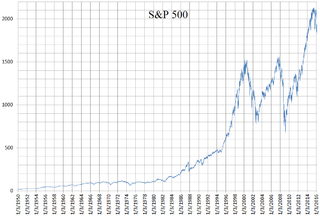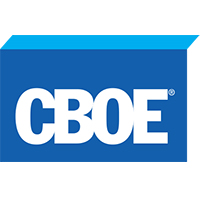Related Research Articles

The Dow Jones Industrial Average (DJIA), Dow Jones, or simply the Dow, is a stock market index of 30 prominent companies listed on stock exchanges in the United States.
An index fund is a mutual fund or exchange-traded fund (ETF) designed to follow certain preset rules so that it can replicate the performance ("track") of a specified basket of underlying investments. While index providers often emphasize that they are for-profit organizations, index providers have the ability to act as "reluctant regulators" when determining which companies are suitable for an index. Those rules may include tracking prominent indices like the S&P 500 or the Dow Jones Industrial Average or implementation rules, such as tax-management, tracking error minimization, large block trading or patient/flexible trading strategies that allow for greater tracking error but lower market impact costs. Index funds may also have rules that screen for social and sustainable criteria.

The Standard and Poor's 500, or simply the S&P 500, is a stock market index tracking the stock performance of 500 of the largest companies listed on stock exchanges in the United States. It is one of the most commonly followed equity indices and includes approximately 80% of the total market capitalization of U.S. public companies, with an aggregate market cap of more than $43 trillion as of January 2024.
The Dow Jones Transportation Average is a U.S. stock market index from S&P Dow Jones Indices of the transportation sector, and is the most widely recognized gauge of the American transportation sector. It is the oldest stock index still in use, even older than its better-known relative, the Dow Jones Industrial Average (DJIA).

The Chicago Board Options Exchange (CBOE), located at 433 West Van Buren Street in Chicago, is the largest U.S. options exchange with an annual trading volume of around 1.27 billion at the end of 2014. CBOE offers options on over 2,200 companies, 22 stock indices, and 140 exchange-traded funds (ETFs).

The S&P Europe 350 Index is a stock index of European stocks.
A capitalization-weightedindex, also called a market-value-weighted index is a stock market index whose components are weighted according to the total market value of their outstanding shares. Every day an individual stock's price changes and thereby changes a stock index's value. The impact that individual stock's price change has on the index is proportional to the company's overall market value, in a capitalization-weighted index. In other types of indices, different ratios are used.
Fundamentally based indexes or fundamental indexes, also called fundamentally weighted indexes, are indexes in which stocks are weighted according to factors related to their fundamentals such as earnings, dividends and assets, commonly used when performing corporate valuations. Indexes that use a composite of several fundamental factors attempt to average out sector biases that may arise from relying on a single fundamental factor. A key belief behind the fundamental index methodology is that underlying corporate accounting/valuation figures are more accurate estimators of a company's intrinsic value, rather than the listed market value of the company, i.e. that one should buy and sell companies in line with their accounting figures rather than according to their current market prices. In this sense fundamental indexing is linked to so-called fundamental analysis.
The S&P/ASX 300, or simply, ASX 300, is a stock market index of Australian stocks listed on the Australian Securities Exchange (ASX). The index is market-capitalisation weighted, meaning each company included is in proportion to the indexes total market value, and float-adjusted, meaning the index only considers shares available to public investors.
The Dow Jones Industrial Average, an American stock index composed of 30 large companies, has changed its components 58 times since its inception, on May 26, 1896. As this is a historical listing, the names here are the full legal name of the corporation on that date, with abbreviations and punctuation according to the corporation's own usage. An up arrow ( ↑ ) indicates the company is added. A down arrow ( ↓ ) indicates the company is removed. A dagger ( † ) indicates a change of corporate name.

S&P Dow Jones Indices LLC is a joint venture between S&P Global, the CME Group, and News Corp that was announced in 2011 and later launched in 2012. It produces, maintains, licenses, and markets stock market indices as benchmarks and as the basis of investable products, such as exchange-traded funds (ETFs), mutual funds, and structured products. The company currently has employees in 15 cities worldwide, including New York, London, Frankfurt, Singapore, Hong Kong, Sydney, Beijing, and Dubai.
The S&P MidCap 400 Index, more commonly known as the S&P 400, is a stock market index from S&P Dow Jones Indices.
The S&P SmallCap 600 Index is a stock market index established by S&P Global Ratings. It covers roughly the small-cap range of American stocks, using a capitalization-weighted index.

In finance, a stock index, or stock market index, is an index that measures the performance of a stock market, or of a subset of a stock market. It helps investors compare current stock price levels with past prices to calculate market performance.
A dividend aristocrat commonly refers to a company that is a member of the S&P 500 index and has increased its dividend for at least twenty-five consecutive years. This core definition is consistent with that of the S&P 500 Dividend Aristocrats. However, there are also different definitions. For example, the S&P MidCap 400 Dividend Aristocrats Index is composed of companies in the S&P MidCap 400 that have increased dividends for fifteen consecutive years.
The 2022 stock market decline was an economic event involving a decline in stock markets globally. The decline was the worst for American stock indices since 2008, ending three-years of gains.
References
- ↑ "S&P 500 Dividend Aristocrats". S&P Global.
- ↑ Strauss, Lawrence C. (February 14, 2020). "When Dividend Aristocrats Lose Their Status, Their Returns Often Improve" . Barron's .
- ↑ Carrel, Lawrence (July 30, 2020). "As More Firms Cut Dividends, Dividend Aristocrats Show Resilience". Forbes .
- ↑ "ProShares S&P 500 Dividend Aristocrats ETF".
- ↑ Ciura, Bob (August 1, 2023). "2023 Dividend Aristocrats List". Sure Dividend .
- ↑ Soe, Aye M. (December 2008). "S&P 500 Dividend Aristocrats" (html). Standard & Poor's . Social Science Research Network. SSRN 1321681.
- ↑ https://www.spglobal.com/spdji/en/documents/indexnews/announcements/20240124-1470263/1470263_spdaudp2024rebalanceannouncement.pdf (PDF). January 24, 2024.
- ↑ https://www.bloomberg.com/news/articles/2024-04-30/3m-to-cut-dividend-on-health-care-spin-losing-aristocrat-status.
- ↑ "S&P Dow Jones Indices Announces Rebalancing Results for the S&P 500 Dividend Aristocrats" (PDF).
- ↑ "Constituent Change Announced for the S&P 500 Dividend Aristocrats Index" (PDF). S&P Dow Jones Indices . August 22, 2023.
- ↑ Assis, Claudia (February 7, 2023). "North Face parent blows past Wall Street quarterly expectations, cuts dividend". MarketWatch .
- ↑ Divine, John (February 10, 2022). "2022's Dividend Aristocrats List: All 65 Stocks". U.S. News & World Report .
- ↑ "S&P Dow Jones Indices Announces Rebalancing Results for the S&P 500 Dividend Aristocrats" (PDF). S&P Dow Jones Indices . January 24, 2021.
- ↑ "Constituent Change Announced for the S&P 500 Dividend Aristocrats Index" (PDF). S&P Dow Jones Indices . March 29, 2022.
- ↑ "Signature Bank, SolarEdge Technologies and FactSet Research Systems Set to Join S&P 500; Others to Join S&P MidCap 400 and S&P SmallCap 600" (PDF). S&P Dow Jones Indices . December 3, 2021.
- ↑ Strauss, Lawrence C. (February 7, 2020). "The 'Dividend Aristocrats' Add 7 New Members" . Barron's .
- ↑ Strauss, Lawrence C. (January 26, 2019). "4 Companies Have Joined the 'Dividend Aristocrats' — but Their Stocks Lag the Market" . Barron's .